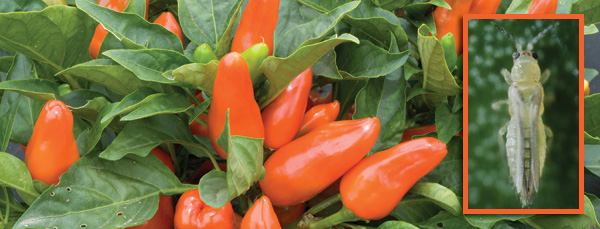Extracts

Mite Could Could Put The Bite On Chili Thrips
Tom Nordlie
Chilli thrips sound more like a snack food than an agricultural menace, but these tiny insects threaten many of the Sunshine State’s most important crops. Fortunately, University of Florida research shows a predatory mite gobbles them up like popcorn.
On bell pepper plants in greenhouses, the mite consumed enough chilli thrips to keep the population to less than one per leaf, compared with 70 per leaf on control plants. Similar results were obtained with peppers grown outdoors. The study was published in April in the journal Biological Control.
Native to Asia, the invasive pest attacks more than 100 host plants, including corn, citrus, peanuts and tomatoes. Established first in the Caribbean, it spread to Florida in 2005 and then to Texas. Adult chilli thrips are about 1 millimeter long.
According to a U.S. Department of Agriculture estimate, if chilli thrips become more widely established in the U. S., they could cause agricultural losses of almost $4 billion per year.
For greenhouse crops — including bell peppers, strawberries, basil and flowers such as Gerber daisies — the mite could provide a much-needed alternative to pesticides, said Lance Osborne, a professor with UF’s Institute of Food and Agricultural Sciences and an author of the study.
“This mite has a lot of potential for greenhouses, which is where it’s used now,” Osborne said. The mite, which has no common name but is known scientifically as Amblyseius swirskii, is available commercially to manage whiteflies and broad mites.
Because the mite is already approved for use in Florida, growers can try it against chilli thrips, he said. Osborne cautioned that the mite is not likely to be successful on every crop the pest attacks. Researchers were happy to find the mite held up well outdoors on bell peppers. Previous attempts to establish the mite outside on rose bushes have been unsuccessful, he said.
“Maybe there is a plant issue — they prefer peppers, but not roses,” Osborne said.
An upcoming project will investigate the use of peppers as “banker plants” — the mite equivalent of birdhouses, said Cindy McKenzie, a research entomologist with the USDA’s Horticultural Research Laboratory in Fort Pierce.
In the project, ornamental peppers will be planted outdoors among rose bushes to see if they can harbor mite populations that protect both plant species, said McKenzie, another author of the study.
If successful, this approach could be helpful to rose gardeners, especially in the Orlando area, hard-hit by chilli thrips. And if you’ve never heard of ornamental peppers, McKenzie said they make a nice addition to the landscape.
“We screened more than 20 ornamental peppers and narrowed it down to four,” she said. “They’re very pretty varieties, with dark purple and green leaves.”
Researchers also hope to develop a pesticide-resistant strain of the mite, Osborne said.
“That way, if a grower has to come in and spray, it won’t disrupt the biological control,” he said. Osborne previously developed a resistant strain of another predatory mite.
The current study was part of an ongoing collaboration between scientists with UF and the USDA, aimed at minimizing chilli thrips damage.